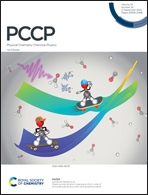Comparative study of Janus B2XY (X, Y = S, Se, Te) and F-BNBN-H monolayers for water splitting: revealing the positive and negative roles of the intrinsic dipole†
Abstract
It is widely recognized that the intrinsic dipole in two-dimensional (2D) photocatalysts promotes hydrogen production during water splitting. Herein, we wonder whether the intrinsic dipole plays a negative role in water splitting. In this work, we make a comparative study of the structural, electronic, and photocatalytic properties of Janus B2XY (X, Y = S, Se, Te) and F-BNBN-H monolayers using first principles. Our theoretical results reveal that both B2XY and F-BNBN-H monolayers exhibit spatially separated conduction band minimum (CBM) and valence band maximum (VBM), as well as vacuum level differences at the opposite surfaces due to the intrinsic dipole. The F-BNBN-H monolayer has excellent redox ability for water splitting, because its CBM is located at the surface with a lower vacuum level and its VBM is distributed on the opposite surface possessing a higher vacuum level. By sharp contrast, B2XY monolayers have limited or vanishing redox ability, because their CBM is located at the surface with a higher vacuum level and their VBM is distributed on the opposite surface with a lower vacuum level. This work emphasizes the negative role of vacuum level differences of photocatalysts caused by the intrinsic dipole in water splitting.



 Please wait while we load your content...
Please wait while we load your content...